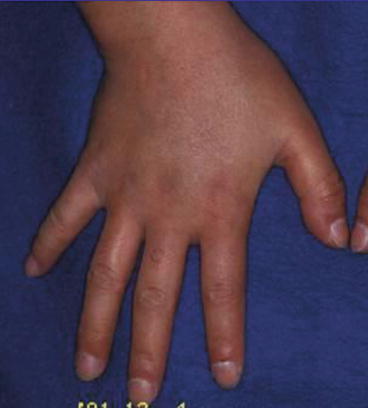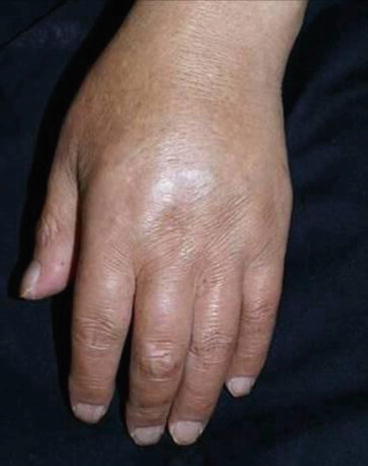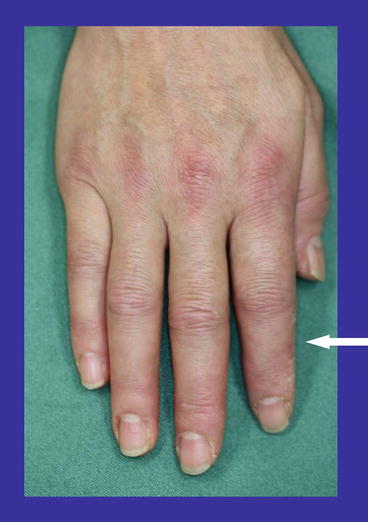Fig. 10.1
Puffy fingers in SSc. (a) lcSSc with ACA, which may tend towards sclerodactyly. (b) lcSSc with ACA, associated with skin gangrenous ulcers but not sclerosis. (c) lcSSc with ACA exhibiting sclerodactyly. (d) lcSSc with anti-Th/To antibody; only puffy fingers without tendency towards sclerodactyly. (e) SSc with anti-topo. Puffy fingers with skin sclerosis. (f) Sclerodactyly following puffy fingers in patients with anti-RNAP
lcSSc with Anti-Th/To Antibody
Autoantibody against Th/To antigen is well known as a serological marker of SSc sine scleroderma [4, 5], meaning that many of the patients with anti-Th/To antibody exhibit only puffy fingers without a tendency to exhibit sclerodactyly. Figure 10.1d shows typical fingers of patients with lcSSc and Th/To antibody.
Early SSc with Anti-Topoisomerase I Antibody (Anti-Topo)
In general, SSc patients with anti-topo develop rapidly progressing skin sclerosis, and most of them are eventually diagnosed with diffuse cutaneous SSc (dcSSc). These patients exhibit puffy fingers tending towards sclerodactyly from an early stage of the disease. Figure 10.1e shows the typical puffy fingers associated with skin sclerosis. Histological examination also showed dermal fibrosis.
Sclerodactyly in dcSSc with Anti-RNA Polymerase Antibody (Anti-RNAP)
The patients with anti-RNAP develop rapid progression of skin sclerosis. Therefore, puffy fingers in this subset accompany development of sclerodactyly with joint contracture. Figure 10.1f shows typical sclerodactyly following puffy fingers.
Anti-u1 RNP Antibody Syndrome
Mixed connective tissue disease (MCTD) was first described by Sharp et al. in 1972 [6]; subsequently, this disease was characterized by the presence of anti-u1 RNP antibody. The clinical entity includes mixed features of different rheumatic diseases such as SSc, systemic lupus erythematosus, and/or dermatomyositis/polymyositis. However, in 1980 LeRoy et al. claimed that this syndrome includes ongoing rheumatic disorders and should be expressed as “undifferentiated connective tissue syndrome (UCTS)” [7].
As described above, a consensus has not yet been reached, and the debate over whether MCTD constitutes a distinct clinical entity has yet to be resolved. However, patients with anti-u1 RNP antibody almost always also exhibit Raynaud’s phenomenon, abnormal capillaroscopic findings, and puffy fingers. In this condition, edematous fingers are generally expressed as “sausage-like fingers.” Therefore, I include above disorders as anti-u1 RNP antibody syndrome in this chapter.
Figure 10.2 shows typical sausage-like fingers in a case of MCTD that we previously observed. Such patients also exhibit mild overlapping clinical features such as low number of WBC, elevated CPK, arthralgia, and mild interstitial pneumonia. Most of these features were improved by oral treatment of low-dosage corticosteroid, with the exception of interstitial pneumonia. Edematous fingers were also improved but not completely cured.


Fig. 10.2
Puffy fingers in MCTD, usually expressed as “sausage-like fingers”
SSc-Like Disorders
Many other conditions present with skin fibrosis and may be confused with SSc. SSc-like disorders include immune-mediated diseases (eosinophilic fasciitis, graft-versus-host disease), deposition disorders (scleromyxedema, nephrogenic systemic fibrosis, systemic amyloidosis), toxic exposures (toxic oil, l-tryptophan, bleomycin, polyvinyl chloride), and genetic syndromes (progeria, stiff skin syndrome) [8]. Some of the above patients may seldom complain of puffy fingers. Figure 10.3 shows nephrogenic systemic fibrosis with slight contracture.


Fig. 10.3
Puffy fingers in nephrogenic systemic fibrosis with slight contracture (This figure was kindly provided by Dr. Nagai of Gunma University, Department of Dermatology)
Anti-aminoacyl-tRNA Synthetase Antibody Syndrome (ARS Syndrome)
ARS is one of the myositis-specific autoantibodies, and patients with ARS frequently exhibit interstitial lung disease [9]. Some cases of ARS syndrome also exhibit Raynaud’s phenomenon and abnormal capillaroscopic findings. Figure 10.4 shows puffy fingers with typical mechanic’s hand. “Mechanic’s hand” is frequently observed in ARS syndrome.










